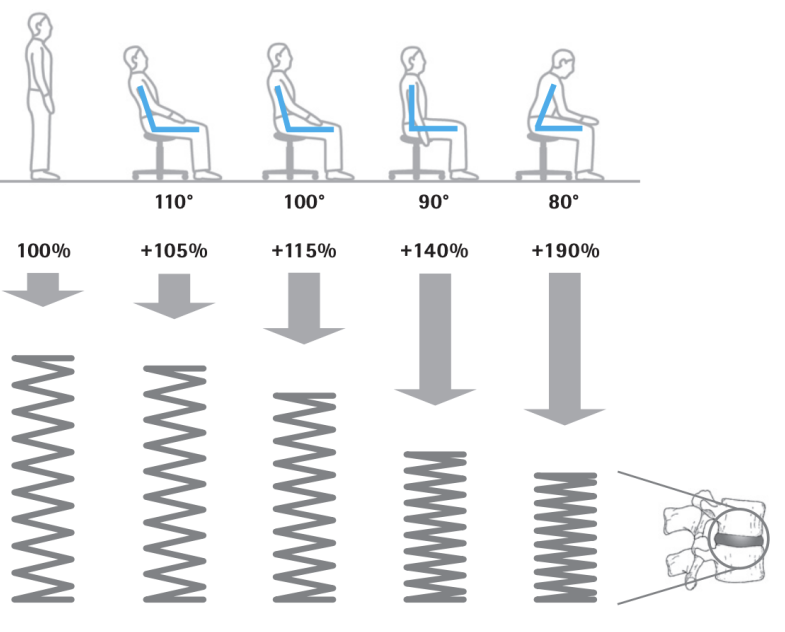
People always think that sitting straight is a good sitting posture. But sitting straight is difficult to adhere to, and people will always sit more and more tired. Because a scientifically good sitting posture is not only to make your back straight while sitting.
A scientifically considered good sitting posture is that all joints and parts of the body are relatively evenly stressed, which prevents some parts from bearing too much weight. This kind of sitting posture is the most energy-efficient posture, and it is professionally called the neutral position.
For sedentary people, a slight backward tilt is a better sitting posture with less pressure on the lumbar spine.
When people are in a long sitting posture, the biggest pressure is lumbar. So scientists specifically for the lumbar intervertebral pressure to do the test, please kindly check the result via the below picture.

Of course, not sit the more back the better. When the lumbar pressure becomes smaller, at the same time, the pressure on the tailbone will increase.
So considering a comprehensive body neutral curvature and pressure on various parts of the body, the more recommended sitting posture is slightly back. This is also one of the reasons why most chairs with backs are designed to tilt back.
Last, but really important, when we sit, straightening the back for a long time really can not be maintained.
Sitting for long periods of time must make people feel uncomfortable, and a better posture should always be dynamic, not static.
A combination of the above factors, from the ergonomic point of view, for the common backrest chair, a better sitting posture is actually a slightly reclined sitting position.
The back of a chair is not a decoration. It not only can help people maintain the stability of the torso spine but also assists a slight backward tilt so that the waist can be in line with a certain lumbar curve of the neutral position. This kind of sitting posture is good and in line with human nature.
We found a suitable office chair that most people can use in an office environment. This is a chair that can be adjusted in height and has castors.
Firstly, you can adjust your waist, as it is the first part that needs to be supported, as much as possible against the back of the chair. At the same time, don’t forget to give the back of your knees and the seat surface to leave a fist-sized distance to ensure that your legs can be parallel to the ground.
The state of your back is close to what we call a relaxed good sitting position as before. This sitting posture works for most chairs.
Pay more attention to the following common wrong sitting postures.

When the height of the desk is not adjustable, you can adjust the height of your chair to allow your small arms in a supported, naturally relaxed typing state, which is at the most energy-efficient angle of 100 to 110 degrees. Check whether your shoulders can naturally sag.
Not all chairs are in line with the curves of your body. When you are leaning back, the waist position is suspended. That is why you need a lumbar pillow. You can put it behind your waist.
Of course, you can get an ergonomic chair that can perfectly fit your back and waist directly.
After adjusting, your hands will be in a more relaxed position. And then you may find that your feet will hang in the air. Then you can step on the small stool to keep yourself in a healthier and more comfortable sitting posture.
Adjust the screen in front of you and your sitting position an arm's length away, and your line of sight parallel position should fall to the top of the screen.
Notebook stands can hold your laptop vertically and help you to adjust the height and angle of the laptop.
And don't forget, sedentary is originally anti-human. There is no one posture (except lying) that is suitable for long-term maintenance. So remember to get up every hour to move around to a relax.

Jun. 21, 2023

Jun. 20, 2023

Jun. 16, 2023

Jun. 15, 2023

Daniel Yao
Yose Lang